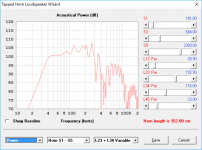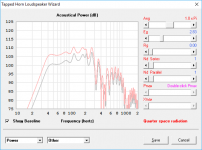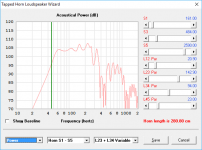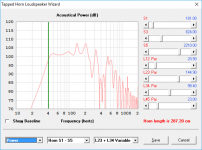LOL - what's old is new again!
BTW, interesting how the author basically managed to get what is essentially a front-loaded horn (albeit with a constant cross-section) with a vented rear chamber patented. How long have those existed?
Last edited:
That's basically a 600 liter (net) alignment for one 15" driver.
Here's what I can get in half of that volume with that same driver, using a simple TH. Notice no significant midbass (100 Hz - 200 Hz) "dip", which IMO is one of the main features of a good TH design. You can fit two of these into the space occupied by one of those ROAR designs, and end up with better efficiency, more SPL output, a flatter and wider passband, AND less group delay in the passband as well (a delta of around 14ms @ 40 Hz compared to the 10ms baseline, as opposed to 27ms for the ROAR design).
Of course an extra 15" driver is needed. TINSTAAFL
Attachments
Clever, I guess you need the second driver for the midbass section
Nope - it's needed for the second 300 l box to achieve the same efficiency level of the 600L ROAR design. Actually, with two of these 300 L THs, the result is more efficient, flatter and capable of greater SPL. And I'll bet they'll be a lot easier to transport too
Attachments
Brian, interesting response coming from one woofer. Can you shift it higher from 40 to 50>60 ish making it more midbass?
It should be possible to do so by shortening the path length and widening the mouth. See example below. However, if I was aiming for midbass operation, I probably wouldn't choose a TH - I'd go with a FLH or simple vented (or sealed) alignment instead.
Attachments
I agree, but achieving that without the risk of compression effects or excessive high power driver loading/fatigue (in your example S2 181, for a driver with an SD of 855), is not easy. if S2 is increased to around a 1/3 SD ratio, so will the rest of the system total volume if you aim for no dip scenario, still, it would be a good TH, only slightly hugeNotice no significant midbass (100 Hz - 200 Hz) "dip", which IMO is one of the main features of a good TH design.
I agree, but achieving that without the risk of compression effects or excessive high power driver loading/fatigue (in your example S2 181, for a driver with an SD of 855), is not easy. if S2 is increased to around a 1/3 SD ratio, so will the rest of the system total volume if you aim for no dip scenario, still, it would be a good TH, only slightly huge
S2 is actually 230 cm^2 for that particular alignment. It's a bit less than 1/3 Sd, but then again we're talking about one of the B&C TBX drivers, right?
S2 is actually 230 cm^2 for that particular alignment. It's a bit less than 1/3 Sd, but then again we're talking about one of the B&C TBX drivers, right?
Here's an even smaller TH using that driver, 40 Hz lower resonance frequency, S2 ~262 L (Sd/3.2) and total volume just over 272 L.
Attachments
Yepp, my bad, i looked at S1, thanks for correcting me.S2 is actually 230 cm^2 for that particular alignment. It's a bit less than 1/3 Sd, but then again we're talking about one of the B&C TBX drivers, right?
A few words on comparing simulation results with finalized cabinets, to regard a simulation system volume result as enclosure size is not correct, it is at best a rough indication.
Translating the simulation into a DIY friendly folding with as little dead volumes as possible and driver access is the tricky part, once that is done we can compare with the finalized cabinet on a more even and fair basis.
Not seldom one has to "simulate backwards" after having built or 3D cad'ed the design, to take the lengths and areas from the finished cabinet or 3D model and see what it means in terms of simulation results, this is how the ROAR series are simulated.
This is no news to you Brian, and not meant as a criticisms of your posts in any way, i know you know this, it is more meant to clarify things in general.
LOL - what's old is new again!
The TH was invented in the 50ies and the quarter wave resonator has been in use for at least five millenia.
If "newness" is a requisite for useful bass speakers then the subwoofer part of diyaudio.com will be an empty and barren wasteland..
Notice no significant midbass (100 Hz - 200 Hz) "dip", which IMO is one of the main features of a good TH design
In what way will a 180 Hz dip be detrimental to a basshorn crossed 24 or 48 dB/octave at 120 - 150 Hz?
A healthy S2 compared to Sd is much more important then keeping the useless rippel in level with the intendant passband.
In what way will a 180 Hz dip be detrimental to a basshorn crossed 24 or 48 dB/octave at 120 - 150 Hz?
Having built and heard systems with and without said dip, my preference is clearly for those that don't have it. And trying to use higher -order LP filtering in an attempt to address a horrible response above the passband is IMO a sub-optimal solution. YMMV.
A healthy S2 compared to Sd is much more important then keeping the useless rippel in level with the intendant passband.
Perhaps. I'd also say that keeping box size reasonable is also important. 600 L for one 15" that can barely reach 40 Hz is IMO is far from reasonable. Keeping group delay in the passband as low as possible is also important, and that particular alignment achieves a delta of 27ms at the lower end of its passband. These last two factors would lead me to reject the ROAR design outright. As always, YMMV
Last edited:
600 L for one 15" that can barely reach 40 Hz is IMO is far from reasonable. Keeping group delay in the passband as low as possible is also important
One 600 liter box with one B&C 15TBW100 is much cheaper then two 300 liter boxes with two B&C 15TBW100. Most people is quite price sensative.
If you feel that the added cost of additional drivers and amplifiers is not a problem you should build closed boxes with multiple B&C 21IPAL.
A 200 liter box with two 21IPAL should play as loud a your 300 liter THs, and as an added bonus they will have a really low GD.
trying to use higher -order LP filtering in an attempt to address a horrible response above the passband is IMO a sub-optimal solution
A normal Dbx driverack has 48 dB filtering as standard. You might want to call their engineers and tell them that they are obviously wrong in offering that as a choice to us.
Your simulated TH has a much worse response above the passband.
The ROAR has some acustic filtering of its own.
I'd also say that keeping box size reasonable is also important. 600 L for one 15" that can barely reach 40 Hz is IMO is far from reasonable.
Hang on a bit
could not agree more, but if it had to come at a price, id rather that price be in the lower end of the passband and not the crossover or kick region, it's all a matter of compromise, show me a design that does not compromise, and I have yet to hear the effects of 27ms GD.Keeping group delay in the passband as low as possible is also important and that particular alignment achieves a delta of 27ms at the lower end of its passband
Ok, Personally I require a lot more info before reaching that statement.These last two factors would lead me to reject the ROAR design outright
Let's keep any debating about horn extensions or waveguide please.
Sorry, you are right, we got a bit away from things, back on topic.
A normal Dbx driverack has 48 dB filtering as standard. You might want to call their engineers and tell them that they are obviously wrong in offering that as a choice to us.
Hmm... following that reasoning, my Hyundai is capable of doing just under 100 MPH. Should I contact them and tell them that they're obviously wrong in designing it to hit that top speed? LOL.... Just because it's an option doesn't mean that it should be used
Your simulated TH has a much worse response above the passband.
..only if you don't understand that HornResp modeling does not include the effect of losses and the "peaks" are usually a lot less peaky in reality. In any case, a bit of damping in the S1-S2 region can flatten it even further than necessary. It's certainly a lot better than trying to address a response that looks like a cross-section of the Grand Canyon that starts just outside of the design passband.
- Home
- Loudspeakers
- Subwoofers
- Horn Extender/Wave-guide for TH



